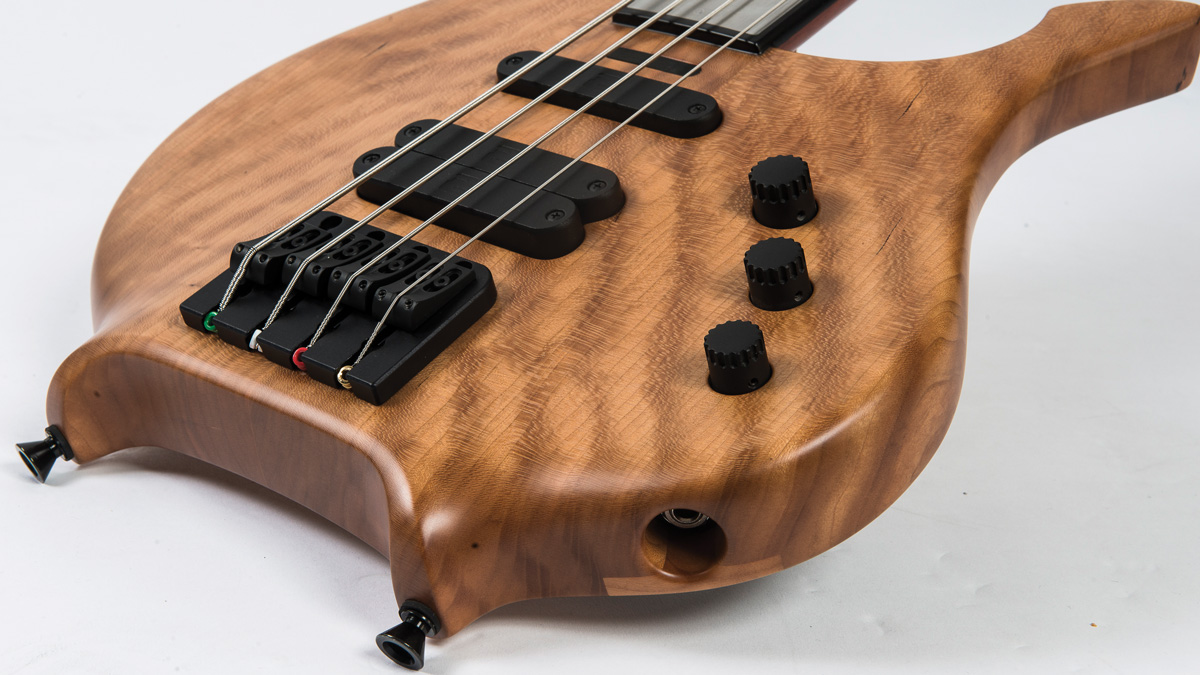MusicRadar Verdict
A fine instrument that ticks many boxes.
Pros
- +
A very interesting instrument, well thought out and extremely playable.
Cons
- -
£7000 is a lot of money...
MusicRadar's got your back
Ever since Jaco Pastorius applied epoxy resin to the rosewood fingerboard of his Fender Jazz bass, bassists have searched for ever-harder fingerboard materials to make their fretless performances stand out from the norm.
Ebony has been popular, as has the ‘polished glass’ ebony and polyester mix used by Michael Pedulla, but German luthiers Le Fay have taken to using a stainless steel board for their aptly-named Remington Steele bass. A glued-in neck system - referred to as a ‘pipe’ - allows 30 per cent less body timber to be removed during construction: let’s see what else lies beneath the bonnet.
Build
The Remington Steele is certainly rather quirky in the looks department. Its elongated top horn is feasible due to the extreme lower cutaway, so lovers of the upper regions of a fretless bass
will be in dusty-end heaven.
Perhaps because of the unusual body dimensions and shape, there is very little headstock bias and the bass balances very well indeed, whichever strap button the player wishes to utilise.
Although the body contouring isn’t what we might commonly expect, it has usable curvature around the control area and the rear portion of the body.
Naturally, your attention is grabbed by the ebony-bound stainless steel fingerboard, although you may think it might look odd, especially without position markers on the front - although position lines on the side edge offer a good point of reference. The hardware feels very solid and sturdily-fitted.
Sounds
So does the fingerboard detract from the fretless tone? Not a bit of it! The passive nature of this bass undoubtedly has a large say in the tonal delivery, but for those of you who might baulk at the thought of a metal fingerboard - perhaps with recollections of the aluminium necks of the 1980s Kramer basses - you can be sure that this bass supplies plenty of warmth and a throaty delivery without being clanky.
If anything, the tonal possibilities are quite wide, made all the better by the six-position pickup selector: this offers a varied palette of tones to pick from. Acoustically, the bass has good sustain and a resonant quality: as a fretless, that can only be a good thing.
This is a passive instrument, fortunately: an active EQ might well make the bass overly responsive, and the passive electronics provide a refined set of tonal parameters to work with. With a single treble cut control, the player really only has to work with the pickup settings to find their core sounds: you can then decide if you want extra treble or not.

Lovers of ‘mwah’ will be very pleased with the response on offer, while those who like a fatter, rounded fretless tone merely have to find their preferred pickup setting.
The 30 per cent extra body timber makes an obvious difference here, with the extra string and note attack due to the metal fingerboard counter balanced by the smooth but lively contribution of the neck and body timbers.
With a 19mm string spacing at the bridge, a 38mm nut width and a standard D-shaped neck profile, this bass is a joy to play, with a natural organic feel despite the less traditional materials: the sum of its parts works very well.
The sealed pore satin finish applied to the neck and body removes the overly glossy feel that most new instruments have, while the setup is quite wonderful and most welcoming to the player. Comfort and playability have been designed in, with the jagged cutout around the glued-in neck joint giving the neck a smooth transition into the body. An amusing touch is the mirror finish of the fingerboard, which invites you to gaze at the reflection of your fretting hand as you whiz up and down the fret-free neck.
At £7000, the pricetag will no doubt hold this bass back somewhat - but it is a handcrafted instrument that has had much time put into it. Note that a cheaper version is available at a tad over £5000. Sure, there are plenty of fretlesses that could provide a similar job, but let your ears and fingers decide. You might just find that the Le Fay offers fretless nirvana.
“A synthesizer that is both easy to use and fun to play whilst maintaining a decent degree of programming depth and flexibility”: PWM Mantis review
“I feel like that song had everything we needed to come back with”: Bring Me The Horizon’s Lee Malia on Shadow Moses, its riff and the secrets behind its tone, and why it was the right anthem at the right time
“I said, ‘Are we sure we can write a song about death?’”: The story of Mike + The Mechanics' classic No.1 The Living Years










